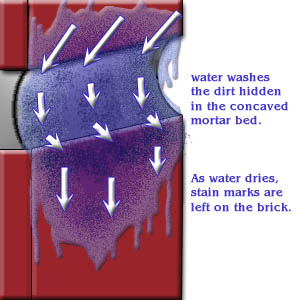Case 2
- Introduction
- Causes of Defects
- Good Practices
- Standards
- Maintenance and Diagnostics
- Remedial
- Similar Cases
- References
Cause of Defects
Staining can be defined as a mark or discolouration that is not easily removed. It is the result of the deposition of airborne dirt on the facade followed by washing off during rainfall (Table 1).

Possible localized deposition of rainwater is encountered, a greater intensity of staining is observed arising from dirt deposition, erosion and absorption[1].
Incompatibility of materials can also lead to staining. Due to smoother surface texture of concrete, rainwater will run down concrete, bringing along any dirt particles and depositing the dirt particles on brickwall, which has a rougher surface texture.
Dirt deposition also occurs on the mortar joints as they act as crevices for the dirt to be trapped. The dirt stains are visible even though the brick wall is dark in colour.
| Pollutants | Examples | Sizes | Sources | Possible effects |
| Aerosols | Sulphur dioxide (SO2) | Gaseous | Burning of fuels | Formation of acid rain. Reaction with water and other materials to form sulphates and chlorides to cause destruction to façade materials. |
| Soot or black smoke | Smoke from tobacco, coal, fuel oil, metallurgical industry | <1 pm | Imperfect combustion | Transported by air and deposited on facades to cause stains |
| Coarse particulate matter | Ash, dust, rock debris, mineral dust. | >1 pm | Unburnt fuel and dust from roads and industries | Transported by air for short distances and deposited more easily on horizontal or sloping surfaces to form stains. |
Table 1: Types of air pollutants that may cause staining to facades.
Possible sources of water:
- Moisture from condensation: Condensation problems can occur in air-con buildings when warm, moist outdoor air is driven towards cooler, drier interior spaces.
- Water mainly originate from rainwater and manifest into many forms which include dampness, deposition of foreign matters, solution of salts etc [1].
Consequences
If left unchecked, the staining would spread to the whole facade and affects the aesthetics of the building.
Staining on a facade has a lot to do with the pattern of rainwater runoff, which in turn is dependent on the facade configuration, colour, texture, as well as the “roughness” and “water absorption” properties of the materials used:


See also Staining of Facades